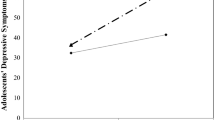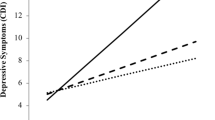Abstract
Children victimized by peers are at increased risk of ongoing depression. This study investigates treatment resistant depression in children victimized by peers, following participation in a targeted cognitive behavioral family intervention. The sample comprised 39 children aged 6–12 years with elevated depression compared with a general sample, prior to the intervention. Six months after the intervention, 26 were no longer depressed and 13 were still depressed. This study investigated the differentiation of these two groups on the basis of parenting and child factors. Children with treatment resistant depression were discriminated from other children by lower levels of peer support and facilitative parenting immediately after the intervention. It was concluded that ongoing support from parents and peers is needed to reduce the risk of ongoing depression even if victimization has been reduced. Further research could develop a comprehensive profile of children at risk of depression following peer victimization.
Similar content being viewed by others
Notes
As Cronbach’s alpha is sensitive to the numbers of items in scales, we calculated the mean inter-item correlation for scales with only two three items which exhibited a low alpha, as recommended [49]; the optimal range for inter-item correlation (r) is between .20 and .40.
References
Coghill D, Usala T (2006) Mood disorders in children and adolescents. Psychiatry 5:123–127
Lack CW, Green AL (2009) Mood disorders in children and adolescents. J Pediatr Nurs 24:13–25
McLeod BD, Weisz JR, Wood JJ (2007) Examining the association between parenting and childhood depression: a meta-analysis. Clin Psychol 27:986–1003
Bhatia SK, Bhatia SC (2007) Childhood and adolescent depression. Am Fam Phys 75:73–80
Egan SK, Perry DG (1998) Does low self-regard invite victimization? Dev Psychol 34:299
Olweus D (1992) Victmization by peers: antecedents and long-term outcomes. In: Rubin KH, Asendorf JB (eds) Social withdrawal, inhibition and shyness in childhood. Lawrence Erlbaum, Hillsdale, pp 315–341
Kochenderfer BJ, Ladd GW (1996) Peer victimization: cause or consequence of school maladjustment? Child Dev 67:1305–1317
Farrington DP, Loeber R, Stallings R, Ttofi MM (2011) Bullying perpetration and victimization as predictors of delinquency and depression in the Pittsburgh Youth Study. J Aggress Confl Peace Res 3:74–81
Sourander A, Jensen P, Rönning JA, Niemelä S, Helenius H, Sillanmäki L et al (2007) What is the early adulthood outcome of boys who bully or are bullied in childhood? The Finnish “From a Boy to a Man” study. Pediatrics 120:397–404
Hodges EVE, Perry DG (1999) Personal and interpersonal antecedents and consequences of victimization by peers. J Personal Soc Psychol 76:677–685
Reijntjes A, Kamphuis JH, Prinzie P, Telch MJ (2010) Peer victimization and internalizing problems in children: a meta-analysis of longitudinal studies. Child Abuse Negl 34:244–252
Harrington R, Whittaker J, Shoebridge P (1998) Psychological treatment of depression in children and adolescents: a review of treatment research. Br J Psychiatry 173:291–298
Weisz JR, McCarty CA, Valeri SM (2006) Effects of psychotherapy for depression in children and adolescents: a meta-analysis. Psychol Bull 132:132–149
Emslie GJ, Mayes TL, Laptook RS, Batt M (2003) Predictors of response to treatment in children and adolescents with mood disorders. Psychiatr Clin North Am 26:435–456
Fava M, Davidson KG (1996) Definition and epidemiology of treatment-resistant depression. Psychiatr Clin North Am 19:179–200
Healy KL, Sanders MR, Iyer A (2015) Parenting practices, children’s peer relationships and being bullied at school. J Child Fam Stud 24:127–140
Healy KL, Sanders MR, Iyer A (2015) Facilitative parenting and children’s social, emotional and behavioral adjustment. J Child Fam Stud 24:1762–1779
Healy KL, Sanders MR (2014) Randomized controlled trial of a family intervention for children bullied by peers. Behav Ther 45:760–777
Abramson LY, Metalsky GI, Alloy LB (1989) Hopelessness depression: a theory-based subtype of depression. Psychol Rev 96:358–372
Cole DA, Turner JE (1993) Models of cognitive mediation and moderation in child depression. J Abnorm Psychol 102:271–281
Prinstein MJ, Cheah CSL, Guyer AE (2005) Peer victimization, cue interpretation, and internalizing symptoms: preliminary concurrent and longitudinal findings for children and adolescents. J Clin Child Adolesc Psychol 34:11–24
Perren S, Ettekal I, Ladd G (2013) The impact of peer victimization on later maladjustment: mediating and moderating effects of hostile and self-blaming attributions. J Child Psychol Psychiatry 54:46–55
O’Donnell EH, Moreau M, Cardemil EV, Pollastri A (2010) Interparental conflict, parenting, and childhood depression in a diverse urban population: the role of general cognitive style. J Youth Adolesc 39:12–22
Auerbach RP, Bigda-Peyton JS, Eberhart NK, Webb CA, Ho MH (2011) Conceptualizing the prospective relationship between social support, stress, and depressive symptoms among adolescents. J Abnorm Child Psychol 39:475–487
Cornwell B (2003) The dynamic properties of social support: decay, growth, and staticity, and their effects on adolescent depression. Soc Forces 81:953–978
Hodges EVE, Boivin M, Vitaro F, Bukowski WM (1999) The power of friendship: protection against an escalating cycle of peer victimization. Dev Psychol 35:94–101
Baker ÖE, Bugay A (2011) Mediator and moderator role of loneliness in the relationship between peer victimization and depressive symptoms. Aust J Guid Couns 21:175–185
Papafratzeskakou E, Kim J, Longo GS, Riser DK (2011) Peer victimization and depressive symptoms: role of peers and parent–child relationship. J Aggress Maltreatment Trauma 20:784–799
Tanigawa D, Furlong MJ, Felix ED, Sharkey JD (2011) The protective role of perceived social support against the manifestation of depressive symptoms in peer victims. J Sch Violence 10:393–412
Egeland B, Kalkoske M, Gottesman N, Erickson MF (1990) Preschool behavior problems: stability and factors accounting for change. J Child Psychol Psychiatry 31:891–909
Kim-Cohen J, Caspi A, Rutter M, Polo-Tomas M, Moffitt TE (2006) The caregiving environments provided to children by depressed mothers with or without an antisocial history. Am J Psychiatry 163:1009–1018
Eisenberg N, Fabes RA, Schaller M, Carlo G, Miller PA (1991) The relations of parental characteristics and practices to children’s vicarious emotional responding. Child Dev 62:1393–1408
Fabes RA, Eisenberg N, Karbon M, Bernzweig J, Speer AL, Carlo G (1994) Socialization of children’s vicarious emotional responding and prosocial behavior: relations with mothers’ perceptions of children’s emotional reactivity. Dev Psychol 30:40–55
Robinson LR, Morris AS, Heller SS, Scheeringa MS, Boris NW, Smyke AT (2009) Relations between emotion regulation, parenting, and psychopathology in young maltreated children in out of home care. J Child Fam Stud 18:421–434
Masten AS, Shaffer A (2006) How families matter in child development: reflections from research on risk and resilience. In: Clarke-Stewart A, Dunn J (eds) Families count: effects on child and adolescent development. Cambridge University Press, New York, pp 5–25
Bowes L, Maughan B, Caspi A, Moffitt TE, Arseneault L (2010) Families promote emotional and behavioural resilience to bullying: evidence of an environmental effect. J Child Psychol Psychiatry 51:809–817
Bilsky SA, Cole DA, Dukewich TL, Martin NC, Sinclair KR, Tran CV et al (2013) Does supportive parenting mitigate the longitudinal effects of peer victimization on depressive thoughts and symptoms in children? J Abnorm Psychol 122:406–419
Graziano PA, Keane SP, Calkins SD (2010) Maternal behaviour and children’s early emotion regulation skills differentially predict development of children’s reactive control and later effortful control. Infant Child Dev 19:333–353
Luby J, Heffelfinger A, Mrakotsky C, Hildebrand T (1999) Preschool feelings checklist. Washington University, St Louis
Jacobson NS, Truax P (1991) Clinical significance: a statistical approach to defining meaningful change in psychotherapy research. J Consult Clin Psychol 59:12–19
Luby JL, Heffelfinger A, Koenig-McNaught AL, Brown K, Spitznagel E (2004) The preschool feelings checklist: a brief and sensitive screening measure for depression in young children. J Am Acad Child Adolesc Psychiatry 43:708–717
Crick NR, Casas JF, Ku HC (1999) Relational and physical forms of peer victimization in preschool. Dev Psychol 35:376–385
Healy KL, Sanders MR (2008) Things Kids Do. Parenting and Family Support Centre, The University of Queensland, Brisbane
Asher SR, Wheeler VA (1985) Children’s loneliness: a comparison of rejected and neglected peer status. J Consult Clin Psychol 53:500–505
Asher SR, Hymel S, Renshaw PD (1984) Loneliness in children. Child Dev 55:1456–1464
Crick NR, Casas JF, Mosher M (1997) Relational and overt aggression in preschool. Dev Psychol 33:579–588
Healy KL, Sanders MR (2008) Sensitivity to peer behaviour interview. Parenting and Family Support Centre, The University of Queensland, Brisbane
Healy KL, Sanders MR (2008) Facilitative parenting scale. Parenting and Family Support Centre, The University of Queensland, Brisbane
Briggs SR, Cheek JM (1986) The role of factor analysis in the development and evaluation of personality scales. J Pers 54:106–148
Healy KL, Sanders MR (2016) Resilience Triple P Facilitator’s Manual. Brisbane: Triple P International Pty Ltd
Gold MS, Bentler PM (2000) Treatments of missing data: a Monte Carlo comparison of RBHDI, iterative stochastic regression imputation, and expectation-maximization. Struct Equ Model 7:319–355
Tabachnick BG, Fidell LS (2007) Using multivariate statistics. Allyn & Bacon/Pearson Education, Boston
Strassburger K, Bretz F (2008) Compatible simultaneous lower confidence bounds for the Holm procedure and other Bonferroni-based closed tests. Stat Med 27:4914–4927
Blanca MJ, Arnau J, López-Montiel D, Bono R, Bendayan R (2013) Skewness and kurtosis in real data samples. Methodology (Gott) 9:78–84
Perneger TV (1998) What’s wrong with Bonferroni adjustments. BMJ 316(7139):1236–1238
Cole DA, Maxwell SE (2003) Testing mediational models with longitudinal data: questions and tips in the use of structural equation modeling. J Abnorm Psychol 112:558
McDowell DJ, Parke RD (2009) Parental correlates of children’s peer relations: an empirical test of a tripartite model. Dev Psychol 45(1):224–235
Mezulis AH, Hyde JS, Abramson LY (2006) The developmental origins of cognitive vulnerability to depression: temperament, parenting, and negative life events in childhood as contributors to negative cognitive style. Dev Psychol 42(6):1012–1025
Finnegan RA, Hodges EVE, Perry DG (1998) Victimization by peers: associations with children’s reports of mother-child interaction. J Pers Soc Psychol 75:1076–1086
Kiel EJ, Maack DJ (2012) Maternal BIS sensitivity, overprotective parenting, and children’s internalizing behaviors. Personal Individ Differ 53:257–262
Mullins LL, Fuemmeler BF, Hoff A, Chaney JM, Van Pelt J, Ewing CA (2004) The relationship of parental overprotection and perceived child vulnerability to depressive symptomotology in children with type 1 diabetes mellitus: the moderating influence of parenting stress. Child Health Care 33:21–34
Acknowledgments
Thank you to the children and families who participated in this trial of Resilience Triple P, the data-base of which was used for analyses reported in this paper. We gratefully acknowledge the funding of the trial by the Australian Research Council supplemented by a philanthropic donation by the Butta and Filewood families. We thank local theme-park, Dreamworld for providing discount cards for families.
Author information
Authors and Affiliations
Corresponding author
Ethics declarations
Conflict of interest
The Triple P–Positive Parenting Program is developed and owned by The University of Queensland. The university, through its main technology transfer company Uniquest Pty Ltd, has licensed Triple P International (TPI) Pty Ltd to publish and disseminate Triple P worldwide. Royalties stemming from published Triple P resources are distributed to the Faculty of Health and Behavioural Sciences, School of Psychology, Parenting and Family Support Centre and contributory authors. Karyn L. Healy and Matthew R. Sanders are both contributory authors of Resilience Triple P and may in future receive royalties from TPI. Karyn L. Healy is employed on occasion as a contract trainer for TPI and may, in future, be offered contract work training practitioners in Resilience Triple P. TPI is a private company and no author has any share or ownership of it. TPI had no involvement in the study design, collection, analysis or interpretation of data, or writing of this report.
Rights and permissions
About this article
Cite this article
Healy, K., Sanders, M. Antecedents of Treatment Resistant Depression in Children Victimized by Peers. Child Psychiatry Hum Dev 48, 107–119 (2017). https://doi.org/10.1007/s10578-016-0658-z
Published:
Issue Date:
DOI: https://doi.org/10.1007/s10578-016-0658-z




